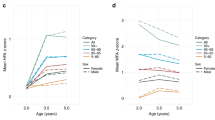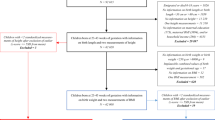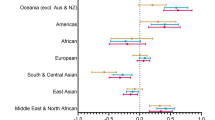Abstract
Background/Objectives:
We studied the association of body weight and weight variability among populations from different geographic, historic and socioeconomic background.
Subjects/Methods:
We reanalyzed data from 833 growth studies of 78 different countries from 1920 to 2013. We used data from two age groups—infants (age 2 years) and juvenile (age 7 years)—and divided the studies into two geographic-socioeconomic groups.
Results:
Multiple regressions showed significant interactions between weight, sex, historic year of study, continent and within-study standard deviation. Multiple regression revealed R2=0.256 (P<0.001) at age 2 years and R2=0.478 (P<0.001) at age 7 years. Although infants and juveniles in more affluent countries are heavier than children in less affluent countries (P<0.001), the within-study standard deviation of the two geographic-socioeconomic groups differs at age 7 years (P<0.001) but not at age 2 years (P>0.15).
Conclusions:
The general impression that prosperous conditions lead to growth improvements in height and weight appears to be true only at a large scale: wealthy countries have tall and heavy children. At small scale, the situation is different. Whereas economic and nutritional improvements can exhibit substantial effects in weight gains, the discrepancy between the within-population variation in height and weight strongly suggests that height gains and weight gains are subject to different regulations.
This is a preview of subscription content, access via your institution
Access options
Subscribe to this journal
Receive 12 print issues and online access
$259.00 per year
only $21.58 per issue
Buy this article
- Purchase on Springer Link
- Instant access to full article PDF
Prices may be subject to local taxes which are calculated during checkout



Similar content being viewed by others
References
Bogin B . Patterns of Human Growth, 2nd edn. Cambridge University Press: Cambridge, UK, 1999.
O’Dea JA, Caputi P . Association between socioeconomic status, weight, age and gender, and the body image and weight control practices of 6- to 19-year-old children and adolescents. Health Educ Res 2001; 16: 521–532.
Wang Y, Zhang Q . Are American children and adolescents of low socioeconomic status at increased risk of obesity? Changes in the association between overweight and family income between 1971 and 2002. Am J Clin Nutr 2006; 84: 707–716.
Gnavi R, Spagnoli TD, Galotto C, Pugliese E, Carta A, Cesari L . Socioeconomic status, overweight and obesity in prepuberal children: a study in an area of Northern Italy. Eur J Epidemiol 2000; 16: 797–803.
Bielicki T . Physical growth as a measure of the economic well-being of populations: the twentieth century. In: Falkner F, Tanner JM (eds). Human Growth: A Comprehensive Treatise. Volume 3: Methodology and Ecological Genetic and Nutritional Effects on Growth, 2nd edn. Plenum Press: New York, NY, USA, 1986, pp 283–305.
Peck AM, Vågerö DH . Adult body height and childhood socioeconomic group in the Swedish population. J Epidemiol Commun Health 1987; 41: 333–337.
Murasko JE . Socioeconomic status, height, and obesity in children. Econ Hum Biol 2009; 7: 376–386.
Komlos J . Height and social status in eighteenth-century Germany. J Interdiscipl Hist 1990; 20: 607.
Silventoinen K, Lahelma E, Rahkonen O . Social background, adult body-height and health. Int J Epidemiol 1999; 28: 911–918.
Fogel RW . Physical Growth as a Measure of the Economic Well-being of Populations: The Eighteenth and Nineteenth Centuries. Plenum Press: New York, NY, USA, 1986.
Harrison GA . Temperature adaptation as evidenced by growth of mice. Fed Proc 1963; 22: 691–698.
Harrison GA, Schmitt LH . Variability in stature growth. Ann Hum Biol 1989; 16: 45–51.
Tanner JM . Growth as a mirror of the condition of society. secular trends and class distinctions. Pediatr Int 1987; 29: 96–103.
Ipsen J, Nowak-Szczepanska N, Gomula A, Aßmann C, Hermanussen M . The association of body height, height variability and inequality. Anthropol Anz 2015, e-pub ahead of print 13 Dec 2015 doi:10.1127/anthranz/2015/0623.
Aßmann C, Hermanussen M . Modeling determinants of growth: evidence for a community-based target in height? Pediatr Res 2013; 74: 88–95.
Hermanussen M, Alt C, Staub K, Aßmann C, Groth D . The impact of physical connectedness on body height in Swiss conscripts. Anthropol Anz 2014; 71: 313–327.
Uauy R, Albala C, Kain J . Obesity trends in Latin America: transiting from under- to overweight. J Nutr 2001; 131: 893–899.
Acknowledgements
The study was supported by the Auxological Society (Deutsche Gesellschaft für Auxologie).
Author information
Authors and Affiliations
Corresponding author
Ethics declarations
Competing interests
The authors declare no conflict of interest.
Rights and permissions
About this article
Cite this article
Mumm, R., Ipsen, M. & Hermanussen, M. The association of weight, weight variability and socioeconomic situation among children. Eur J Clin Nutr 70, 650–652 (2016). https://doi.org/10.1038/ejcn.2016.21
Received:
Accepted:
Published:
Issue Date:
DOI: https://doi.org/10.1038/ejcn.2016.21
This article is cited by
-
Infant body composition at 6 and 24 months: what are the driving factors?
European Journal of Clinical Nutrition (2023)
-
The association between weight, height, and head circumference reconsidered
Pediatric Research (2017)



